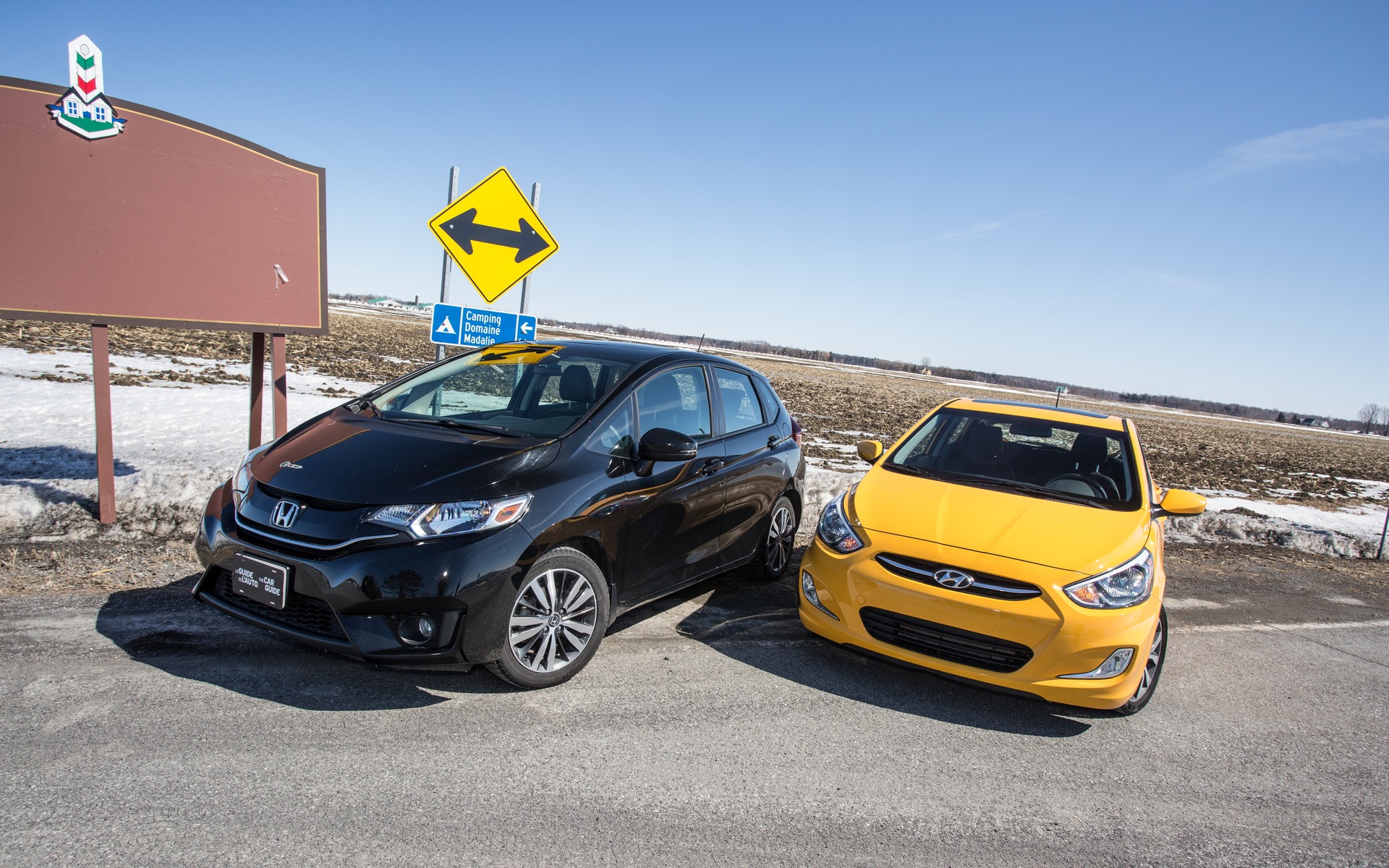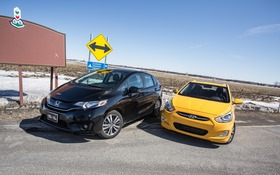Featherweight Battle: Honda Fit Vs. Hyundai Accent
The subcompact category is one of our market’s most popular, and this fact has not been lost on manufacturers. They are offering very competitive vehicles in the segment that are constantly being updated.
That’s why I decided to compare two of our market’s most popular little cars.
Let’s meet the combatants:
In the left corner and wearing bright yellow trunks, we have the Hyundai Accent. Weighing in at 1,195 kilos and hailing from South Korea, this five-door was introduced on our continent in 1994 and its direct descendant has been here since 2011. A fierce adversary, it’s recognized for its attractive base price ($13,599) and for its popularity with Canadian families.
In the right corner and wearing the shiny black trunks, there’s the Honda Fit. At 1,177 kilos, it is the lighter of the two. This Japanese car (assembled in Mexico) is currently in its third generation, with the first arriving here in 2006. But this version has been completely redesigned and revamped for 2015. Although its predecessor was recognized for its playful ride, practical side and frugality, this newcomer still has something to prove.
Let’s get it on!
Round 1: Appearance
While you should never judge a book by its cover, putting these two cars side by side and examining their differences is perfectly acceptable. The Fit looks taller, and it is—by 7.4 centimetres to be exact. This may give it more loading capacity and head room for its passengers, but it makes the Fit seem massive, unlike the much slimmer Accent. This detail notwithstanding, the two subcompacts are very similar. Both feature fog lights, decorative chrome bars and grey painted wheels. In fact, the more you look, the more you realize that they have the exact same characteristics.
Round 2: Passenger compartment
Profound differences become evident once you climb on board. The Honda Fit is very modern with dynamic lines, faux aluminum accents and square buttons. Although the passenger compartment is pretty, some of the plastics don’t feel particularly nice to the touch. The dashboard instrumentation is elementary and efficient, but the small LCD screen just under the driver’s line of sight is a tad outdated. One thing ruins the experience, at least for me: the infotainment system has no buttons. That means that you have to constantly look at its large plastic touchscreen to use it. It would be simpler and more user-friendly to have one or two scroll wheels and a few buttons.
The Accent’s passenger compartment is the opposite. Much simpler, curvier and less stylized, it still gives the impression of quality. Its plastics are thicker and nicer to the touch, the seats are comfortable and the instrumentation is simple and easy to understand. Plus, it offers a distinct advantage: the radio has a nice little scroll wheel to adjust the volume and another to change the station. The ambient temperature can also be changed by turning another dial located below. Same goes for the ventilation. Using it is child’s play, and you can do it without taking your eyes off the road. Great job, Hyundai!
On the other hand, I must admit that the Fit is roomer than the Accent.
Round 3: Driving
The difference between the two cars is accentuated (pun intended) even more when you take the wheel. Right from the start, I was impressed at how quiet it was on board the Accent and by its smooth ride. The six-speed automatic gearbox shifts evenly and the engine doesn’t make too much noise. The steering offers little feedback, but it’s very assisted, which is practical in town. Visibility is average, but the tiny rear window makes it difficult to manoeuvre in certain situations.
As for the Honda Fit, its ride is a succession of great discoveries and disappointments. The power steering is well assisted and provides sufficient feedback, but the manual transmission is not precise and the clutch has a practically non-existent friction point (a continuously variable transmission is available if the six-speed manual doesn’t interest you). Visibility is excellent, especially with the side view mirrors helping you see the front blind spots. But the fact that the Fit sits rather high up doesn’t help the soundproofing. Wind noise is very evident as soon as you hit highway speeds. Lastly, although the Fit’s acceleration isn’t dazzling, the little car is able to go with gusto when push comes to shove.
Today’s winner? The buyer
Like I said in the beginning, the subcompact segment is in constant flux: each manufacturer brings different ingredients, and all of the cars have their strengths and weaknesses.
In today’s match-up, there was no win by knockout. The Hyundai Accent and Honda Fit will both attract a significant number of buyers. However, I have to say that I prefer the little Korean car: it’s quieter, easier to use on a day-to-day basis (all it would have taken is a simple scroll wheel, Honda!) and gives the impression of being better built.












